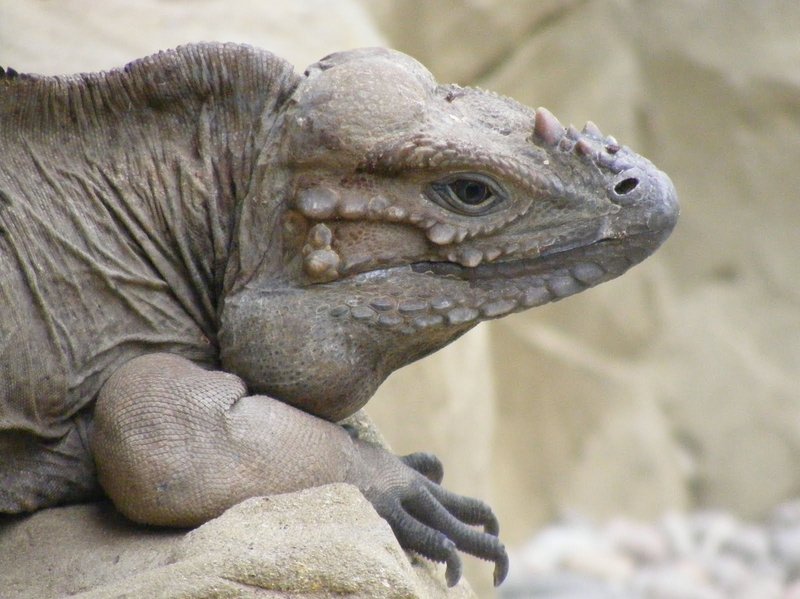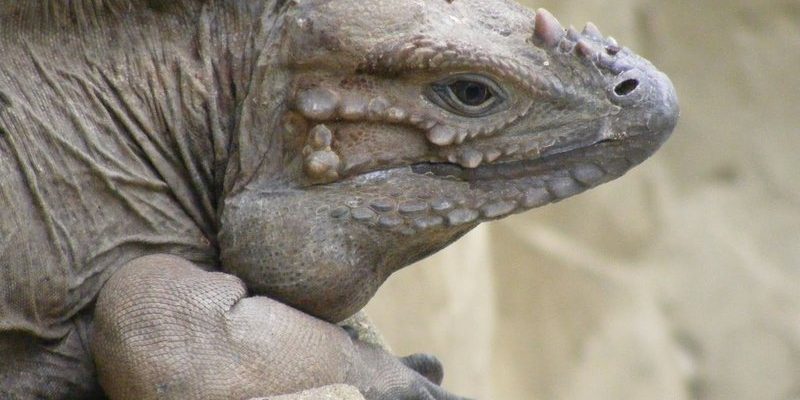
Let’s take a moment to explore what sets these iguanas apart from other species. The *Cyclura cornutum*, commonly known as the Rhino Iguana, is distinguished by its prominent, horn-like casque on the nose, giving it a fierce yet endearing look. As we dive into the details, you might find it helpful to think of identifying this reptile like solving a puzzle. Each piece—from size and color to behavior—fits into the bigger picture.
Physical Characteristics
When you’re trying to spot a Rhino Iguana, the first thing you’ll notice is its distinctive physical features. These iguanas can grow to impressive sizes, typically reaching lengths of 4 to 5 feet. They can weigh anywhere from 10 to 20 pounds, making them one of the larger iguana species.
Their skin is usually a mix of gray and green tones, which can vary depending on the individual. This camouflaging ability helps them blend into their rocky habitat. But the real standout feature? The horned nasal structure on their snout. It’s a characteristic that sets them apart from other iguanas and is often the first thing people notice.
Additionally, their tails are spiky and muscular—a display of their strength. If you see one with a thick, spiny tail, there’s a good chance you’re looking at a Rhino Iguana. These traits not only contribute to their rugged appearance but also play a role in their survival in the wild.
Habitat and Distribution
Rhino Iguanas are native to the Hispaniola island, which consists of Haiti and the Dominican Republic. They thrive in dry, rocky regions and subtropical forests. You might find them basking on sunlit rocks or hiding among the foliage. Understanding their habitat can help you identify them in the wild or know what to recreate if you’re considering one as a pet.
They prefer environments with plenty of climbing opportunities. In a pet setting, their enclosure should mimic these natural conditions. This means providing branches, hides, and ample space to roam. They are not just ground dwellers; they love to climb! If you see a robust iguana hanging out in a high spot, it’s likely a Rhino Iguana enjoying its territory.
Structuring their living conditions with these elements not only aids in identification but also ensures they stay healthy and happy. So if you’re looking around, keep an eye out for environments that suit their natural tendencies.
Behavioral Traits
Now, let’s talk about behavior. Rhino Iguanas have some interesting quirks that can help you identify them. Generally, they’re semi-ambitious creatures. They often display curious behavior, especially when they’re in a new environment. If you catch one exploring its surroundings, it’s likely a Rhino Iguana. They enjoy digging and will often burrow into soft soil or sand, revealing their adventurous side.
These iguanas can also be a bit territorial. Males, especially during mating season, might engage in displays that include puffing up their bodies or bobbing their heads. If you see one acting assertively, it might be a male asserting its dominance. Conversely, if it seems more relaxed, it could be a female, which tend to be less aggressive.
Being aware of these behavioral traits can help you discern a Rhino Iguana from other species, especially if you’re observing them in a natural setting or at a reptile show.
Diet and Feeding Habits
Identifying a Rhino Iguana isn’t just about their looks; it’s also about what they eat. These reptiles are primarily herbivorous, favoring a diet that includes a variety of leafy greens, fruits, and vegetables. If you happen to be in a situation where you can observe their feeding, look for them munching on items like dandelion greens, hibiscus flowers, or even slices of mango.
They have strong jaws that help them chew through tough plant material. If you see an iguana chomping down with vigor, there’s a good chance it’s a Rhino Iguana. Plus, they require a good amount of calcium and vitamins—so keep an eye on how well they’re thriving on their diet.
If you’re thinking of keeping one as a pet, it’s crucial to replicate their natural diet as closely as possible. This doesn’t just help you identify them but also keeps them in optimal health!
Color Variations
You might be surprised to learn that Rhino Iguanas can display some variations in color. While most have a grey-greenish hue, their colors can shift based on factors like age, health, and the environment. Younger iguanas often appear brighter, while older ones may take on a more muted tone.
If you’re trying to identify one, pay attention to these subtle changes. It’s like watching a painting evolve over time. The brightness of their colors can also indicate how well they’re adapting to their environment. A vibrant iguana is likely healthy and well-cared for, showcasing the beauty we associate with Rhino Iguanas.
It’s also worth noting that some Rhino Iguanas may exhibit patterns on their skin—another deciding factor in identification. These markings can provide clues about their age and well-being, helping you understand more about the specific iguana you’re looking at.
Conservation Status
Understanding the conservation status of Rhino Iguanas is essential, especially if you come across one in the wild. These reptile wonders are classified as vulnerable, primarily due to habitat loss and hunting. Awareness of their status can help you appreciate the need for their protection.
If you spot a Rhino Iguana, consider it a special moment. You’re witnessing a creature that plays a vital role in its ecosystem. They help to seed dispersal, aiding plant growth in their habitats. Promoting awareness about their conservation can lead to efforts to protect them, ensuring these unique reptiles remain a part of our world.
By understanding their situation, we can help advocate for their needs, whether through supporting conservation programs or simply educating others about their fascinating lives.
Why Identifying Rhino Iguanas Matters
So, why should you care about identifying a Rhino Iguana? Well, knowing how to spot one can enhance your appreciation for these incredible creatures. Whether you’re considering adopting one or just want to learn more, being informed enriches your experience. Plus, educating others about Rhino Iguanas can foster a greater understanding of wildlife conservation.
Identifying them can also be crucial for their protection. The more people know about these iguanas, the more they can advocate for their preservation. Raising awareness means that as a community, we can contribute to their conservation efforts, making a positive impact on their habitat.
In a way, identifying a Rhino Iguana isn’t just about seeing them; it’s about connecting with nature and understanding the intricate web of life. It’s a reminder of our responsibility to protect the earth and its inhabitants.
In conclusion, identifying a Rhino Iguana requires a blend of observing physical traits, behavior, diet, and understanding their conservation status. Whether you’re encountering one in the wild or thinking of welcoming one into your home, knowing these elements can help you appreciate their unique qualities. Embrace the journey of learning, and you might find these remarkable reptiles hold a special place in your heart.

